- Author
- A.N. Other
- Subjects
- History - general
- Tags
-
- RAN Ships
- None noted.
- Publication
- September 2018 edition of the Naval Historical Review (all rights reserved)
By John McGrath
This article is a complement to that on officers’ swords which appeared in the March 2018 issue of the Naval Historical Review. Like that article, it does not pretend to give an exhaustive coverage of the subject but to offer an introduction to the types of cutlasses that have been used. Perhaps it is as well to dispel some popular misconceptions over the origin of the name. You may hear that it comes from ‘cut lash’ or ‘cut lace’ but it is far simpler. It is related to those familiar words ‘cutler’ and ‘cutlery’ and derives from the Latin ‘cultellus’ meaning knife.
One aspect of the cutlassthat is often overlooked is its dual function; not only was it a weapon but it also served as a damage control tool useful for cutting away cordage, etc. This accounts for the substantial weight of cutlasses. In this respect it complemented the naval tomahawk or boarding axe with its primary role of damage control and its secondary purpose as a useful weapon.
Early days
In the early years of the eighteenth century, officers are often illustrated with one or other of two types of swords. Now distinguished by collectors as hangers and hunting swords, the only real difference was that the former had curved blades and in the latter they were straight, Fig. 1. Some collectors theorise that the cutlass derived from the hanger and the dirk from the hunting sword but there is little evidence in support of that theory and quite a bit to refute it. As the century progressed, a cutlass with either a straight or a curved blade and a figure-of-eight (double-disc) guard developed. Early specimens had handles made from antler but this would have been expensive and later this was replaced by a simple iron tube, Fig. 2. Although cheap, this would have afforded a very poor grip making it difficult to direct the point and edge of the weapon accurately. The quality of these swords, produced by many different suppliers without quality assurance supervision was very variable, with the worst being very poor indeed.
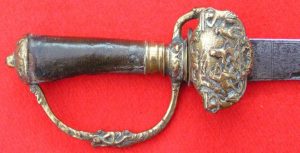
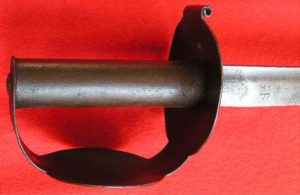
The 1804 Pattern Cutlass
This state of affairs could not be allowed to continue so, in 1804, the first official pattern cutlass was introduced. This had a straight, flat blade that was about 28¼ in (730 mm) long; it retained the figure-of-eight guard with a vestigial quillon but the unsatisfactory cylindrical grip was replaced with one of cast iron, shaped to the hand and provided with 17 circumferential and 6 longitudinal groves, Fig. 3.
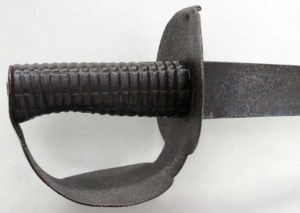
The blade was engraved with the Royal Cypher; a crown above the letters GR. It was carried in a brown leather scabbard with a frog hook but no top locket, and a brass chape. There was no pommel; the guard being riveted in place on the grip by peening over the tang of the blade. In common with all official patterns it was provided with a slot in the guard for a sword knot. This is curious as the RN never issued a sword knot with its cutlasses. This slot may reflect the fact that naval weapons were supplied by Army, until 1854 by the Board of Ordnance and thereafter by the War Office. The Army issued sword knots to cavalry troopers. Although sometimes referred to as the Trafalgar Pattern, it is uncertain how many would have been on board ships at that action and many were produced under later contracts.
The 1845 Pattern
The end of the wars with France and the USA and the subsequent reduction in the size of the RN meant that there was no imperative to seek a better weapon. Despite this, experimental designs continued to be evaluated and in 1842 the RN accepted a new pattern. A major fire at the Tower of London delayed its introduction and bulk supplies seem to have become available around 1845. This is why this date has been chosen rather than the more usual 1842; it is all rather irrelevant except to anoraks. The new sword, Fig. 4, differed in many respects from its predecessor.

This new pattern had the longest blade of all the uniform cutlasses, 29½ in (750 mm), was slightly curved with a flat back and an acute spear point well suited to thrusting. It is the first cutlass to reflect trends in cavalry swords and this influence on the design of cutlasses was to remain right up to the final pattern. The bowl guard, which lacked any form of quillon, tapered towards the pommel close to which there was a slot for a sword knot. This weak area of the guard was reinforced by being turned downwards, away from the grip. The grip remained cast iron but only had 12 circumferential grooves. A small pommel, technically described as a burr, was fitted.
The Enfield cutlass/sword bayonet, Pattern 1859
In the years following the 1845 Pattern, the RN made the transition from muzzle loading smooth bore muskets to breech loading rifles. This started with the muzzle loading Enfield rifle of 1859 which was converted to breech loading using the Snider mechanism in 1867. The concept of a bayonet, which could also serve as a cutlass, gained traction. The Enfield cutlass/sword bayonet of 1859, Fig. 5.

This weapon had a flat, slightly curved blade which was 27 in (686 mm) long, 1½ in (38 mm) wide at the shoulder and terminated in a double edged spear point. The hilt assembly consisted of a sheet steel guard with a slot for a sword knot close to the pommel where it is reinforced by folding outwards. Inside the guard there is a muzzle ring/quillon with an internal diameter of 13/16 in (21 mm). On the opposite side is a reinforcing plate. A mortise to attach this weapon to the rifle runs the length of the grip. The pommel has a catch operated by a leaf spring on the right hand side and a stud on the other. The tang is riveted over a small burr. There are two types of grip. The earlier, sealed on 18 April 1859, is leather covered wood with six circumferential grooves. This grip must have been too slippery because on 1 May it was replaced by a knurled leather grip. The scabbard was black leather and fitted with a top locket carrying a frog hook, and a chape; both these fittings were made of steel.
The Martini-Henry cutlass/sword bayonet, Pattern 1871
Introduction of the Martini-Henry rifle started in 1869 and two years later came its version of the cutlass/sword bayonet, Fig 6. This new weapon had a straight blade, 25½ in (650 mm) long and 1¼ in (32 mm) wide at the shoulder. The muzzle ring had an internal diameter of 0.71 in (18 mm). Many of these were provided by straightening and shortening the 1859 Pattern and bushing the muzzle ring. The new blade profile could not be produced directly by grinding down the blades of earlier weapons; hot forging was required. Following this, an expensive quenching and tempering heat treatment was needed to restore the properties. Contractors avoided this and supplied blades which had not been heat treated with the result that they bent when used in anger. This was one of a number of such ‘sword scandals’ during the nineteenth century which affected both the cavalry and the RN. The specimen illustrated is one such, bearing ‘S’ stamps for manufacture at Solingen and ‘E’ stamps dating from its conversion at Enfield in 1878. It is not stamped ‘R’ and therefore was not heat treated after conversion. Like its predecessor, the scabbard was black leather with two steel mounts.
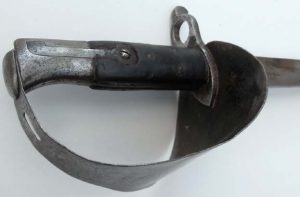
The 1887 Pattern
Meanwhile, many modified versions of the 1845 Pattern were tested, usually in small batches and with blades which could not be formed from the original without hot forging. These variations are too numerous and too badly documented to cover in detail but one is described later. In 1887, a blade was finally designed which could be produced from the 1845 Pattern by grinding alone. The resulting weapon had a blade that was 26½ in (680 mm) long and 17/16 in (37 mm) wide at the shoulder. It is compared with the earlier pattern in Fig. 7.

Pressure from multiple sources forced the authorities to act and introduce proper tests for edged weapons taken into Government service. This development was reported in The Engineerof 8 March 1889. This coincided with the appearance of a completely new pattern of cutlass.
The 1889 Pattern.
This represented a step change in design and closely mirrored developments in the swords of cavalry troopers that had started in 1882. The new cutlass, Fig. 8, was a complete break from earlier designs. It had a straight, flat blade which was 28 in (711 mm) long and 13/16 in (30 mm) wide at the shoulder. It had a double edged spear point. The sheet steel guard was innovative with an everted rim to the bowl. As well as providing added strength to the guard, it would have acted as a stop rib, a common feature in the design of armour that was intended to catch the point of a weapon glancing off a curved surface and guide it harmlessly away. The cast iron grip looks to be rather too cylindrical in cross section to afford a really secure grip. This sword was carried in a black leather scabbard with two steel mounts, the locket being fitted with a stud for use with a belt frog.

The 1900 Pattern
Yet another pattern of cutlass was introduced in 1900, Fig. 9. This differed from its predecessor because a shallow fuller ran along each face of the blade for about one third of its length. The bowl guard from the 1889 Pattern was retained but the grip was different. Perhaps the smooth grip had generatedcriticismandit was replacedbya much more rectangular cross section faced with black leather cheeks. An innovation was the small concave insert between the heel of the grip and the guard adjacent to the pommel. This finger rest which was intended to cushion the little finger of the sword hand was copied from the 1890 Pattern sword for cavalry troopers. The scabbard was the same as for the previous pattern.
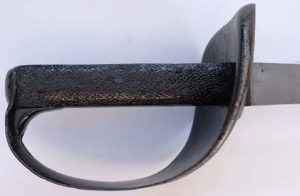
This was to be the last pattern of cutlass in the RN. The order withdrawing the cutlass from service was issued on 22 October 1936.
May and Annis state that these last two patterns were issued with bright steel guards. However, many examples of both these patterns are to be found with blackened mounts. ‘Shiny cutlery’ was certainly being used for ceremonial purposes as late as the start of the 21st century, so it is possible that both blackened and bright mounts were issued or that cutlasses were blackened on board to reduce the amount of cleaning necessary.
Some other cutlasses
A few other cutlasses that are outside the direct line of evolution of the naval weapon are worth mentioning. Three of these will be examined here.
The ex-Army saw-backed cutlass
Towards the end of the nineteenth century some of the stocks of the Army’s 1856 Pattern saw-backed pioneer swords were taken into naval service, see Fig. 10.
It had a blade which was 22½ in (571 mm) long by 1⅜ in (35 mm) wide at the shoulder. The back of the blade had a double saw edge commencing ¾ in (20 mm) from the guard and terminating 7¼ in (184mm) from the point. The blade was two edged for the final 6¾ in (172 mm) and ended in a spear point. The all brass hilt had a stirrup hilt with a quillon and an oval slot for a sword knot close to the pommel. The grip consisted of a pair of brass scales, each with 12 transverse grooves. The black leather scabbard had two brass mounts, the top locket being fitted with a frog stud.
Examples of this weapon with Army markings are quite common but those taken into naval service and marked to indicate this transition are scarcer. Fig. 11 illustrates the naval ownership mark, N, while there is another example (not shown) with the date on which it was transferred to the RN, 4’ 92, for April 1892.
According to May and Annis (see Bibliography), some of these swords were transferred to the Navy because in the organisation of Naval Brigades each rifle company had attached to it a pioneer armed with this weapon. They mention a report of one being seen in use ashore during the Boxer Campaign of 1900. Withdrawn from Army use in 1903, this sword remained in naval use for a few more years.

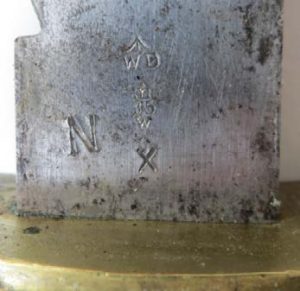
The Coastguard cutlass
Following the passing of the Coastguard Act of 1856, that organisation came under Admiralty control. It remained so until after WWI when was civilianised. It was, again, placed under the Admiralty during WWII. Its uniforms and weapons usually closely followed RN patterns but there were exceptions, one of which was a cutlass, Fig. 12.
It had a curved blade 25 in (635 mm) long measured in a straight line from the shoulder to the point of the back edge which curved by 1⅜ in (35 mm) from the straight. It was 17/16in (36 mm) wide at the shoulder and terminated in a very acute point. A single, narrow fuller ran along each side of the blade from the shoulder to within 7½ in (190 mm) of the point. The brass guard was a stirrup hilt with a quillon with additional protection afforded to the hand by a loop on the outer side. The cast iron grip was shaped to fit the hand and had 19 grooves cast into its surface. (The countersunk hole was probably made to mount the sword in a wall display). The sword was carried in a brown leather scabbard which had a brass frog hook but no top locket and a brass chape.

Experimental cutlasses
A combination of scientific curiosity and the profit motive meant that efforts were always being made to design better weapons and then persuade the authorities to accept them. From time-to-time examples of these experimental weapons turn up. The specimen illustrated, Fig. 13, is one such, combining features of the 1845 Pattern with novel elements such as an ergonomic grip and a bowl guard where the weak point associated with the redundant slot for the sword knot has been removed.
The blade for this sword was made by F&W Deakin and it carries no Government markings suggesting that this was a private venture by Francis S. Deakin, who traded in Birmingham from 1840–1850, and an unrecorded member of the same family. These dates would fit the blade, bowl guard and burr that have been used. A very similar weapon but with a cast iron grip is illustrated by Comfort, EW171 (see Bibliography).

What does the dictionary say?
The most authoritative definition might well be that in the Oxford English Dictionary:
A short sword with a flat wide slightly curved blade, adapted more for cutting than for thrusting; now esp.the sword with which sailors are armed.
This probably agrees with the general public’s ideas about this weapon but how accurate are the descriptors: short, flat, slightly curved, and adapted more for cutting? In fairness, it does state that this entry, first published in 1893, has not yet been fully updated.
One feature common to all the uniform cutlasses of the Royal Navy seems to have been overlooked. All the blades were single edged, with the back of the blade being flat. Ideally, any definition would mention this design feature. Although the term cutlass is correctly applied to the swords that were worn by members of the customs and police services, it is accepted that this is a specialised use of the term and that, nowadays, it is generally reserved for the swords of naval ratings.
Retaining the structure of the current entry, it is suggested that a more accurate definition would be:
A short sword with a wide, single-edged, flat-backed blade that may be either straight or slightly curved, flat or grooved; now esp. the sword with which sailors are armed.
Select Bibliography
1.A Manual of Gunnery for Her Majesty’s Fleet, London, Printed for Her Majesty’s Stationery Office, by Harrison and Sons, St. Martin’s Lane, 1873.
- Comfort, Sim, Naval Swords & Dirks, London: Sim Comfort Associates, 2008.
- Gilkerson, William, Boarders Away with Steel – Edged Weapons & Polearms, Lincoln, Rhode Island: Andrew Mowbray, 1991.
- Instruction for the Exercise of Small Arms and Field Pieces, etc, for the use of Her Majesty’s Ships,London, Harrison and Sons, 1859. A modern facsimile version is available: Uckfield, The Naval & Military Press Ltd, n.d..
- May, W.E., Commander RN and Annis P.G.W., Swords for Sea Service,London: Her Majesty’s Stationery Office, 1970.
- May, WE, and Kennard, AN, Naval Swords and Firearms, London: HM Stationery Office, 1962.
- McGrath, John and Barton, Mark, British Naval Swords & Swordsmanship, Barnsley, Seaforth Publications, 2013.
- Oxford English Dictionary, on-line version.
- Verity, Liza, Naval Weapons,London: National Maritime Museum, 1992.
- Wolfe, Sarah C, Naval Edged Weapons, London: Chatham Publishing and Pennsylvania: Stackpole Books, 2005*-




